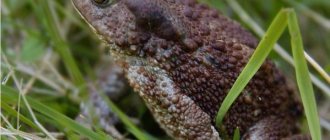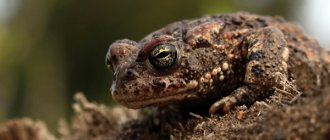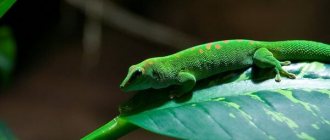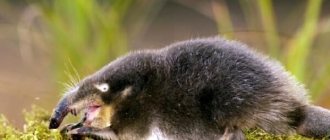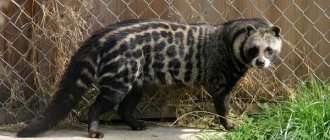Toads - what kind of animals are they? Photos of toads, a description of these tailless amphibians and the most interesting facts about toads in our article. We will also answer the question: “Are toads and frogs the same animal? or still not?
Who is this toad? This question is often answered incorrectly, because few people know that real toads are not frogs, tree frogs or toads, which are so similar in appearance to toads.
Science has now determined that toads are representatives of the family of round-tongues (genus of the midwife toad) and the family of true toads. In total, there are about 304 species of these animals on Earth.
Reed toad (Bufo calamita).
The appearance of toads is typical of all representatives of the order of tailless amphibians. These amphibians have a rather large head, their limbs are located not under the body, but on the sides. The body itself of toads has a flattened shape. Unlike “long-legged” frogs, the limbs of toads are relatively short. Males on their front legs are naturally endowed with small protuberances - tubercles, or nuptial calluses (they are necessary to hold the female during mating).
Malayan toad (Bufo melanostictus).
The size of toads can vary from 2.5 centimeters in length to 27 centimeters. The weight of these amphibians also varies greatly: from several grams to one kilogram. Male toads are always smaller in size compared to females.
American toad (Anaxyrus americanus, or Bufo americanus).
The skin of toads, and this is another significant distinguishing feature, is covered with warts. Toads also have parotid glands called patroids. By nature, toads are endowed with a unique property: their skin and patroids are capable of secreting mucus, which can not only protect the skin from drying out, but also save the animal itself from the enemy (since the mucus is often poisonous).
Common or gray toad (Bufo bufo) in a threatening pose.
If you touch a frog, warts will appear: is this true? According to scientific research, this is a myth, since the appearance of warts is provoked by a virus, which clearly does not arise due to the unattractiveness of toad skin.
The cane toad or aga (Bufo marinus) eats an earthworm.
As for the color of toads, most often these animals have inconspicuous tones: brown, black, grayish. There are noticeable spots on the body. But this rule does not apply to tropical toads, which are also very poisonous. These amphibians can have skin in a variety of bright shades: red, orange and others. Such flashy colors warn the enemy that he himself may get hurt if he wants to taste the toad.
Kinds
The green toad is an amphibian whose skin is olive with a gray tint. On its back there are spots of dark green color, they are decorated with black stripes. To protect themselves from predators, toads secrete a special juice that is very toxic. These toads almost never jump, but seem to walk.
green toad
The common ground toad is the largest species. The body of a mature toad is heavy and wide, the color is brown or grayish. The amphibian's eyes are orange.
Common toad
Another common species is the Caucasian toad. The length of the individual is 10-13 cm. The skin is beige or gray. Individuals of this species prefer to settle in places where there is almost no light, namely in caves.
Caucasian toad
Far Eastern ground toads are the most unusual species, as you can find individuals of both gray and brown, and green and yellow. Toads have spines and stripes on their bodies. Amphibians live in dark forests.
Far Eastern toad
The reed toad is distinguished by its large yellow stripe on its body. The length of an adult toad is 8 cm. The color can be olive or yellowish.
Reed toad
Mongolian toads can be recognized by their round heads and bulging eyes. The body of individuals of the species is flattened, its length is about 9 cm. There are many warts on the skin of amphibians.
Mongolian toad
The viviparous toad is the smallest. The body length of the individual is only 3 cm. Interestingly, this toad has no teeth at all. Another distinctive feature is the amphibian’s black eyes. The toad lives 10-40 years.
Viviparous toad
Enemies
The main enemies of the toad are:
- owls
- crows
- rats
- snakes
- hedgehogs
The amphibian's camouflage body color and toxic mucus secreted from a special gland behind the eyes help protect the amphibian from them.
When a predator tries to swallow a toad, the poison release mechanism is triggered, which causes an instant gag reflex in the enemy. The poisonous secretion is harmless to humans; the poison is used in the production of medicines.
When defending itself from an attack, a common toad of a small predator is quite capable of frightening it itself by swelling up and taking on an aggressive appearance. In emergency situations, it rises to its paws, trying to scare away the enemy. A toad in a calm state moves at a walk.
Having noticed a person or large animal, the amphibian freezes, and when trying to approach it, it is able to jump like a frog.
External features of the squad
These amphibians are unique. These amphibians have almost no teeth on the upper jaw; they have glands - parotids, which secrete poison. And on the forelimbs of males there are tubercles with which they hold the female during mating.
Most species of the order have a large head. All amphibian limbs have fingers connected by a membrane. Thanks to this structure, they can quickly jump through the water.
Pipovye
The pipidae family is one of the most primitive among tailless amphibians. For example, they lack a tongue, ribs and movable eyelids. The most famous member of this family is the smooth clawed frog (Xenopus laevis), common in Central Africa. The species owes its name to the black claws (spurs) on the first three toes of the hind limbs. This frog is a favorite subject for genetic experiments and biomedical research, it is very easy to keep in captivity and can often be found in pet stores. It is interesting that clawed frogs live constantly in water and, like fish, have a lateral line with which they navigate in muddy water. The natural color of these frogs is brownish-olive, and in captivity albinos (individuals whose bodies lack dye pigments) are often found.
Albino smooth clawed frog
No less famous is the Surinamese pipa (Pipa pipa) from South America. Pipa reproduction is perhaps one of the most amazing natural phenomena. During mating, the male smears the eggs on the female's back and presses them into the mucus-covered skin. The eggs are enclosed in cells 1 cm deep and 0.5 cm in diameter and covered with leathery caps on top. The partitions of the cells resemble a honeycomb; they are rich in blood vessels that supply the embryo with nutrients. After about 80 days, the fully formed young pipas break through the operculum and leave the mother's body.
Surinamese pipas
Where does it live?
Ground toads inhabit almost the entire globe, with the exception of Antarctica. But previously, toads did not inhabit Australia either, but scientists artificially created poisonous toads there.
These amazing amphibians can be found in Europe, namely in Ukraine, Belarus and Sweden, in the Russian Federation.
Gray toad
Varieties of frogs
There are more than 500 species of frogs in the modern world. To simplify perception, representatives of amphibians were conventionally divided into the following subfamilies:
- toad-like;
- scythe-dactyls;
- real;
- African forest;
- dwarf;
- Discopals.
The following are considered the most amazing and unusual frogs in the world:
- transparent (glass) - individuals grow up to only 2 cm, have colorless skin through which all internal organs are visible;
- Cocoy poison frogs are miniature amphibians that produce a strong toxic venom in their skin that is superior to the most dangerous snakes in the world;
- hairy - unusual amphibians in which hair grows on the back and serves as a kind of respiratory organs;
- Goliath frogs are one of the largest tailless frogs, growing up to 40 cm and weighing up to 3.5 kg;
- pointed-nosed arboreal - have an unusual nose;
- bullfrogs are large individuals that produce a deafening croaking sound;
- flying frogs - small amphibians famous for their long jumps; they are capable of jumping up to 12 meters.
Researchers claim that a large number of frog species are still unknown to humanity. Therefore, scientists are happy to continue to study the animal world in anticipation of new discoveries.
What do they eat?
These tailless animals feed on butterflies and snails, insect larvae and juveniles.
Sexually mature individuals, which are large in size, can catch frogs and rodents, lizards. But catching these small animals is not so easy. Therefore, toads can sit in ambush for hours, waiting for the moment.
The search for food takes place only in the summer, and toads always hunt alone. They form groups only during the mating season. In winter, amphibians hibernate. Before this, toads find empty mouse holes or nest right in the roots of a tree.
Nutrition
The adult common toad feeds on animal food. With its long tongue, it catches small invertebrate animals such as spiders, ants, earthworms, snails, flies and beetles. She is not afraid of poison and bee stings.
The gray toad also eats small frogs, lizards, salamanders and mice. She even feeds on the young of her own species. Gray frogs hunt at night. At this time, the gray toad slowly walks around its area in search of the desired prey. She also has another strategy: she sits motionless in one place and waits for the prey to approach her.
The gray toad is distinguished by the fact that it swims relatively well and moves quite quickly on the ground. However, despite this, she is a sedentary animal.
The common toad reacts to the movement of potential prey. As soon as any insect moves, the frog shoots out its long sticky tongue, which, having grabbed the victim, is immediately pulled back.
Reproduction
The breeding season starts in the spring. In tropical latitudes, this period begins with the rainy season. At this time, toads create groups near rivers with swamps. This happens because toads can only spawn in water. Males come first to the mating sites, and then females. Expectant mothers immediately enter the river and begin spawning. Then fertilization occurs.
These eggs later turn into tadpoles. They spend about 2 months in the pond. The diet of tadpoles consists of algae and small plants. After this time, the tadpoles turn from small awkward creatures into toads and emerge from the water. The speed of development of amphibians depends on the type of toad and the temperature of the “home”. This usually takes from 5 to 60 days. There is also a viviparous toad, but it can only be found in Africa. An individual can give birth to 20-25 toads at a time.
Keeping a toad at home
Unpretentious amphibian inhabitants have become popular for home keeping in terrariums. Horizontal aquariums with amphibians are placed in shaded areas, away from loud sounds. Expanded clay and gravel are used as soil, a shelter and a small pool of water are installed.
Toads' appetite is always excellent. In captivity, their food is usually slugs, cockroaches, crickets, and special food from a pet store. For the inhabitants of the terrarium, the factor of prey movement is important, so large toads prefer mice, rat pups, chicks, and frogs. Amphibians catch insects with their sticky tongue, and larger objects with their jaws.
Some pets are so tamed that they take food from the owner's hands. kept properly at home Depending on the species, 25-30 years is not the limit for amphibians. The record holder among long-livers was a 40-year-old toad.
Interesting Facts
- Males of some species take on the role of nanny. The male wraps the clutch around his paws and patiently waits for the offspring to appear.
- These amphibians are beneficial to humans. During the day, toads rid crops of 8 g of insects, so the crop spoils less.
- The largest ground toads inhabit Tanzania and West Africa. The body length of such an individual is about 25 cm. But today, these giants are actively dying out; the number of viviparous toads is of great danger.
- The poison that the glands secrete, parotids, is almost harmless to humans; it can only cause a burning sensation.
- Only the viviparous toad becomes very active during periods of total drought.
- During the mating season, females make strange sounds that resemble quacking. When frightened, individuals also “scream”, but this resembles a high-pitched squeak.
Garlics
One of the families of tailless amphibians is the family of spade frogs (Pelobatidae). These frogs, when their skin is damaged, emit a noticeable odor reminiscent of garlic (hence the Russian name). Unlike all other amphibians, spadefoots have a characteristic vertical pupil and a large horny calcaneal tubercle at the base of the fifth digit of the hind limb. These animals lead a burrowing lifestyle and therefore prefer loose sandy soils. Using their heel tubercles like small shovels, spadefoot spadefoots can completely immerse themselves in the soil in 3-4 minutes. North American spadefoots bear the eloquent name of spadefoots. Dugouts appear on the soil surface only at night or at dusk. Common in Russia, the common spadefoot spadefoot (Pelobates fuscus) is the record holder among domestic amphibians - it has the largest tadpole, which reaches a length of 17.5 cm, while the maximum length of an adult is 7–8 cm.
Common spadefoot
